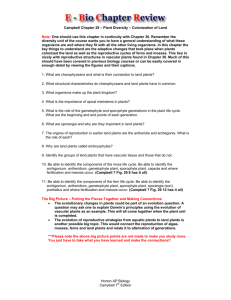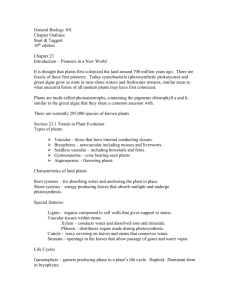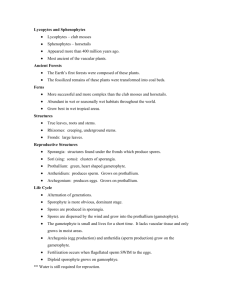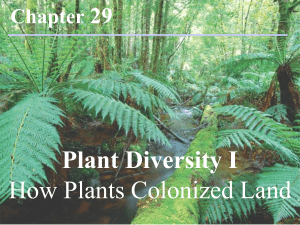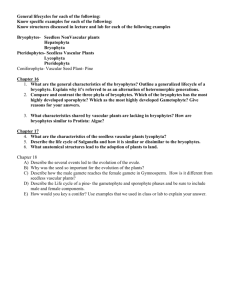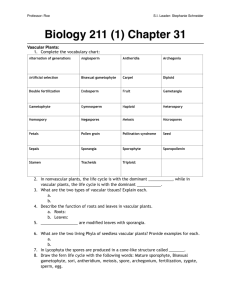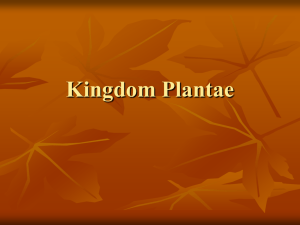CHAPTER 29 PLANT DIVERSITY I: HOW PLANTS COLONIZED
advertisement
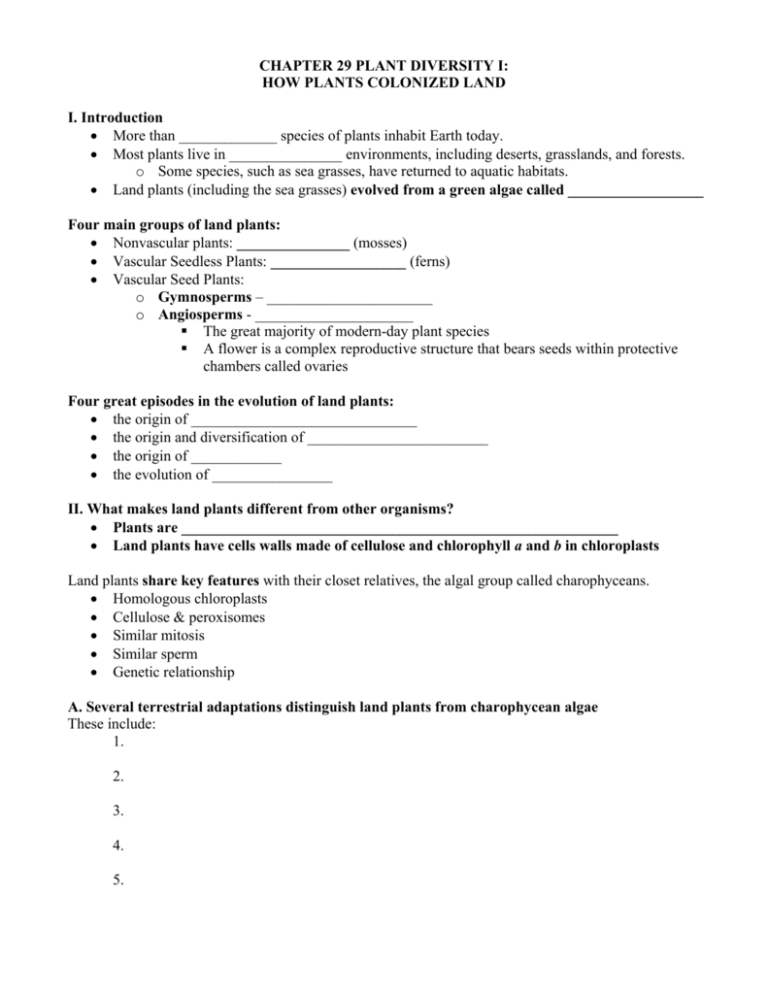
CHAPTER 29 PLANT DIVERSITY I: HOW PLANTS COLONIZED LAND I. Introduction • More than _____________ species of plants inhabit Earth today. • Most plants live in _______________ environments, including deserts, grasslands, and forests. o Some species, such as sea grasses, have returned to aquatic habitats. • Land plants (including the sea grasses) evolved from a green algae called __________________ Four main groups of land plants: • Nonvascular plants: _______________ (mosses) • Vascular Seedless Plants: __________________ (ferns) • Vascular Seed Plants: o Gymnosperms – ______________________ o Angiosperms - _____________________ The great majority of modern-day plant species A flower is a complex reproductive structure that bears seeds within protective chambers called ovaries Four great episodes in the evolution of land plants: • the origin of ______________________________ • the origin and diversification of ________________________ • the origin of ____________ • the evolution of ________________ II. What makes land plants different from other organisms? • Plants are __________________________________________________________ • Land plants have cells walls made of cellulose and chlorophyll a and b in chloroplasts Land plants share key features with their closet relatives, the algal group called charophyceans. • Homologous chloroplasts • Cellulose & peroxisomes • Similar mitosis • Similar sperm • Genetic relationship A. Several terrestrial adaptations distinguish land plants from charophycean algae These include: 1. 2. 3. 4. 5. 1. Apical meristems, localized regions of cell division at the tips of shoots and roots. 2. Multicellular plant embryos develop from zygotes that are retained within tissues of the female parent. • This distinction is the basis for a term for all land plants, _______________________ 3. Alternation of generations = • This life cycle also occurs in all land plants and various algae • does not occur in the charophyceans Sporophyte • • • a mature sporophyte produces haploid reproductive cells called ____________ A spore is a reproductive cell that can develop into a new organism without fusing with another cell. _____________________ of a plant spore produces a new multicellular gametophyte. Gametophyte • produce gametes, egg and sperm • fusion of egg and sperm during fertilization form a _______________________ • mitosis of zygote forms sporophyte A reasonable hypothesis for the origin of sporophytes is a mutation that delayed meiosis until one or more mitotic divisions of the zygote had occurred. This multicellular, diploid sporophyte would have more cells available for meiosis, increasing the number of spores produced per zygote. In bryophytes, the ____________________ is the dominant generation • Larger and more conspicuous than the sporophyte In pteridophytes, gymnosperms, and angiosperms, the ___________________ is the dominant generation • For example, the fern plant that we typically see is the diploid sporophyte, while the gametophyte is a tiny plant on the forest floor 4. Plant spores are haploid reproductive cells that grow into a gametophyte by mitosis • Spores are covered by a polymer called ___________________, the most durable organic material known. • This makes the walls of spores very tough and resistant to harsh environments. • Multicellular organs, called ____________________, are found on the sporophyte and produce these spores. 5. Gametangia = multicellular organs in which the gametophytes of mosses, ferns, and conifers produce their gametes • archegonium = the ______________ gametangium, produces a single egg cell in a vaseshaped organ o The egg is retained within the base. • antheridia = _____________ gametangia o produce many sperm cells that are released to the environment. o The sperm cells of bryophytes, pteridiophytes, and some __________________________________________________ • A sperm fuses with an egg within an archegonium and the zygote then begins development into an embryo. III. Adaptations in land plants • _____________of polyesters and waxes o In most land plants, the epidermis of leaves and other aerial parts are coated o The cuticle protects the plant from microbial attack o The wax acts as waterproofing to prevent excessive water loss. • _____________, in the epidermis of leaves allow the exchange of carbon dioxide and oxygen between the outside air and the leaf interior. • Vascular Tissues - Vascular tissue transports materials among these organs between roots, stems and leaves of land plants (exception: bryophytes) o Xylem – o Phloem – Humans have found many applications, including medicinal applications, for secondary compounds extracted from plants. For example, the alkaloid quinine helps prevent malaria. IV. 3 phyla of bryophytes: mosses, liverworts, and hornworts Bryophytes are represented by three phyla: • phylum Hepatophyta – • phylum Anthocerophyta – • phylum Bryophyta Note: the name Bryophyta refers only to one phylum, but the informal term bryophyte refers to all nonvascular plants The gametophyte is the dominant generation in the life cycles of bryophytes Bryophyte life cycle details: • When plants are coated with a thin film of water, ____________________________________ and fertilize the eggs (drawn by chemical attractants) • The zygotes and young sporophytes are retained and _________________________________ • A bryophyte sporophyte remains attached to its parental gametophyte throughout the sporophyte’s lifetime • Bryophytes are anchored by tubular cells or filaments of cells, called ___________________ • Lacking support tissues, most bryophytes are only a few centimeters tall. • The “leaves” of most mosses ________________________________________________, features that enhance water and mineral absorption from the moist environment. • In most mosses, the stalk (seta) becomes elongated, elevating the capsule (sporangium) enhancing spore dispersal. • The foot gathers nutrients and water from the parent gametophyte via transfer cells. Additional terrestrial adaptations evolved as vascular plants descended from mosslike ancestors • Cooksonia, an extinct plant over 400 million years old, is the earliest known vascular plant. • Its fossils are found in Europe and North America. • The branched sporophytes were up to 50cm tall with small lignified cells, much like the xylem cells of modern pteridophytes. IV. Pteridophytes: Seedless Vascular Plants • Most pteridophytes have true ______________________________________. • From the early vascular plants to the modern vascular plants, the ________________ generation is dominant. Ferns: • key variation among vascular plants: o homosporous vs. heterosporous plants • A _____________________ sporophyte produces a single type of spore. o This spore develops into a bisexual gametophyte with both archegonia (female sex organs) and antheridia (male sex organs) • A _____________________ sporophyte produces two kinds of spores. o ___________________ develop into ________________ gametophytes. o ___________________ develop into __________ gametophytes. (We’ll see this in Chapter 30) • Regardless of origin, the flagellated sperm cells of ferns, other seedless vascular plants, and even some seed plants must ________________________________ • Because of this • Ferns produce clusters of sporangia, called sori, on the back of green leaves (sporophylls) or on special, non-green leaves. o Sori can be arranged in various patterns that are useful in fern identification. o Most fern sporangia have springlike devices that catapult spores several meters from the parent plant. o Seedless vascular plants formed vast “coal forests” during the Carboniferous period.
